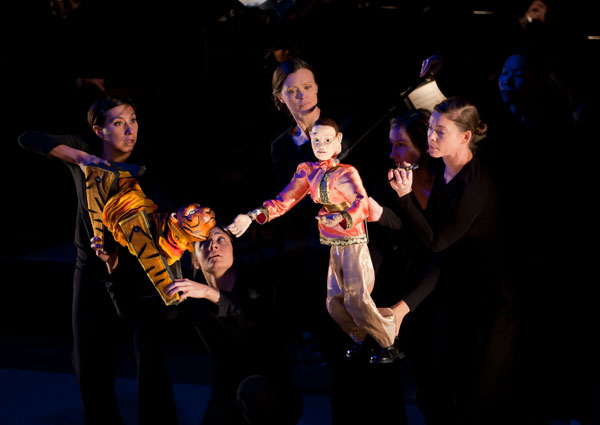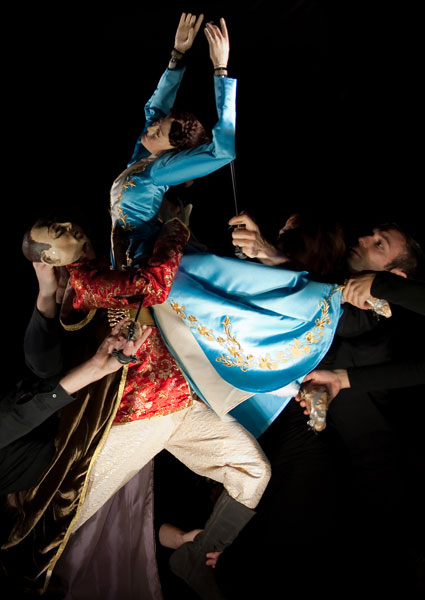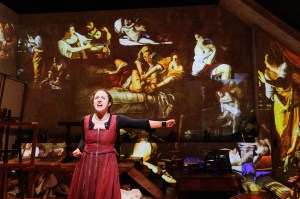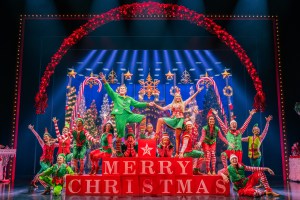Puppeteer Chris Green Mounts a Unique Family Production of Stravinsky's Firebird
The director discusses how he brought new life to the classic ballet through the art of puppetry.

(© courtesy of the production)
In 2010, The Little Orchestra Society, which seeks to foster in children a love for the arts, presented puppeteer Chris Green with a challenge: Stage a production of Stravinsky's Firebird with his own brand of puppetry and storytelling. Green eagerly took on the project, and the fruits of his labor will be presented this weekend in three performances at New York City Center The show, a part of Little Orchestra Society's Happy Concerts for Young People program, will delight children with its retelling of young Prince Ivan and the magical firebird as they listen to Stravinsky's classic score, which will be performed onstage by the Little Orchestra Society Orchestra with David Alan Miller guest-conducting.
TheaterMania spoke with Chris Green about the magic of puppetry, what audiences can expect from the show, and why children are smarter than you think.
What was your inspiration for Firebird?
For me, the inspiration was partly to reimagine this folk epic using the source text, but also to create something that children would feel swept up in, without sacrificing any of the complexities and nuances of puppet theater that I know it has for adult audiences. So I was inspired by the challenge of doing that…What we're doing is staging the suite primarily from the 1945 music, and to the best of my knowledge, the suite hasn't been performed with a visual accompaniment.
This production utilizes Bunraku puppetry. What is that exactly?

(© courtesy of the production)
We're very careful in the puppetry world to specify that it is not traditional Bunraku. Bunraku actually belongs to a particular theater in Japan. And so when we refer to that style where you have multiple performers on one puppet, we say Bunraku style. But what we've borrowed from that is, one lead puppeteer will hold the head and one arm, usually the right, the secondary puppeteer will hold the left arm and the pelvis of the puppet, and then there'll be a third puppeteer on the seat. And they have to work in a sort of perfect synchronicity to make all the actions happen. With the right ensemble, puppets can fly, they can walk in space, they can walk upside down. We're kind of unlimited except by the puppeteers' reach.
How did working with choreographer David Neumann influence the work?
David was very influential…When I brought him in, I wanted him to help me look at how the puppeteers could also be dancers, so that their movements aren't completely obscured by blacks or velvets, but that they are visible and that when they are not holding puppets, their bodies become landscape or part of the stage picture. And that's something that he does extremely well. He understands the seamlessness between the object world and the world of dance. And it creates this flow onstage wherein every movement seems to be deliberate.
Do puppets bring a dimension to this production that is different from when Firebird is performed by humans?
That's such an interesting question, because as a puppeteer we never ask that. We just say, Of course! It's puppetery! [laughs] Other people would say, Well, why puppetry? And you know, …we've had that discussion in rehearsals where we say, "These puppets need to fly higher, they need to extend farther." Because otherwise, if a human can do it, you do have a question: Why are you choosing to use puppetry? And in this case we're talking about a magical realm, an evil sorcerer, who in our version has a floating capacity…a Firebird that can go from a condensed ball of fire to a twenty-five-foot length of flame.
I think for us the sweet spot is that puppetry sort of remains pure, the characters are pure. When you see Ivan the Prince onstage…he is the Prince. His sole raison d'être is to be onstage. When people are watching puppetry, there's…an amazement to the skills that they know are going into making these puppets alive.
Bunraku-style puppetry is different from the other styles that most kids have likely experienced. How do children respond to this kind of puppetry?
I presume that most kids have not been exposed to this kind of puppetry because it's such a rare thing. I think one of the first things that happens is that kids forget they're [watching] puppets. They just look at them as characters. They go with you as soon as you set up a couple of base rules, [for example] that there's a ground that these puppets are walking on [that] doesn't actually exist; these puppets are walking on a three-foot ground level but it's invisible, so we're kind of miming the whole way. Once you set up a couple of stage rules, children are so generous. They say, Yes, that's right. And if the puppet goes beneath that [level], they'll say that it went underground, or if [the puppets] are above, they'll know that they're flying. So I mean, in some ways, [children] are the ideal audience, because they don’t get caught up in technique. They just say, You're telling me a story, it doesn't really matter what you're using, just make the story clear and wonderful and surprise me.
So in general once kids are in the audience, they're very accepting of the world you create and absorbed by what they see.
Well, they'll tell you what they feel. They won't wait. They'll just scream it out…they're the best audiences. If they're with you, you feel it; if not, you'll feel it.
Along the same lines, how do adults react to this style of puppetry?
We always know that our key audience [will be] young people, but for me a young person is between the ages of two and a hundred and five. We've had people in the audience who didn't expect to have any reaction at all become effusive about it, because there's something in it for them too. I'm not of the school that takes theater and dilutes it for young people. I believe children are smarter than adults, they're just less experienced. We've never been concerned that children won't understand it or what's happening. There will be themes in this piece that would probably speak more to children than adults, but there are other themes that will speak more to adults than children. I don't want to be concerned with age. I just think it should be a spectacle that we as a company express and that everyone can follow.
Watch the video below for a quick peek at a rehearsal session in which two puppeteers bring the Firebird to life.










